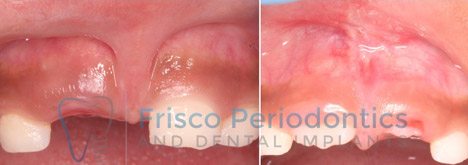Fix Muscle Tissue with a Tongue Tie or Frenectomy in Frisco!
 If you’ve ever examined the bottom of your tongue or gum tissue underneath your lips, you’ve probably noticed a thin attachment that holds them in place. Everyone has this attachment, but for some, this muscle extends farther than normal. While this condition is particularly common in infants and young children, it can occur in anyone. If you’re experiencing symptoms related to these attachments, contact our Frisco, TX location today to schedule an appointment or ask our team any questions you may have.
If you’ve ever examined the bottom of your tongue or gum tissue underneath your lips, you’ve probably noticed a thin attachment that holds them in place. Everyone has this attachment, but for some, this muscle extends farther than normal. While this condition is particularly common in infants and young children, it can occur in anyone. If you’re experiencing symptoms related to these attachments, contact our Frisco, TX location today to schedule an appointment or ask our team any questions you may have.
 What is a Frenum?
What is a Frenum?
Before we can talk about tongue ties, we need to clearly define the parts of the mouth in question. These muscle attachments include the lingual and labial frena, which is the plural form of frenum. The lingual frenum is the muscle attachment that connects the tongue to the floor of the mouth. The maxillary labial frena connect the inside of the upper and lower lips to the gums and just above and below the two front teeth.
In some cases, these attachments can overextend towards the gum line, therefore causing the gum tissue to become thinner and lead to gum recession. When the gums recede, they further expose the root of teeth and increase the risk of sensitivity, tooth decay and loss, and gum infections. It can also lead to diastemas, or gaps, particularly in the two front teeth.
What is a Tongue Tie?
If you’ve ever heard the expression “tongue-tied” before, then you can understand how having an enlarged lingual frenum can impede your ability to perform certain functions. In some cases, young children can accommodate this condition. However, if the frenum extends all the way to the tip of the tongue, it can result in a tongue tie and make it much more difficult to speak, move the tongue and even practice proper oral hygiene.
What is a Frenectomy?
A frenectomy is a very simple and common periodontal procedure meant to remove the frenum in the mouth. This is typically done with small incisions or through laser treatment, depending on what your needs are. You’ll be able to discuss this with our team before you begin any treatment.
What are the Benefits?
A frenectomy can make a big difference in your child’s oral development. By removing an overextending frenum, your child should experience:
- Improved Speech – Tongue tie can interfere with certain sounds requiring specific positioning of the tongue (ex: “th”, “s”, “d”, “t”)
- Easier Breast Feeding – Since babies use their tongue and lips to latch while sucking, a frenectomy can help them maintain a correct position so they can do so properly. A large lingual frenum would make breast feeding more painful and reduce the mother’s ability to produce breast milk and provide nutrition otherwise. Nursing mothers who experience pain from difficulty latching should further discuss this with their periodontist.
- Improved Oral Hygiene and Lower Risk of Oral Disease – Children and adults often discover it difficult to sweep food debris from certain areas of the mouth with a larger frenum. Reducing it can also work to reduce the risk of gum disease, cavities and the occurrence of gaps in bottom front teeth.
- Better Tongue Movement – Routine and simple activities like licking lips, kissing and playing musical instruments can be more easily performed.
Is your child experiencing issues with speaking, breast feeding or maintaining proper oral hygiene because of this muscle attachment? Contact our office to schedule an appointment today with your Frisco Periodontist, Dr. Zachary Carnow to get them the help they need!

